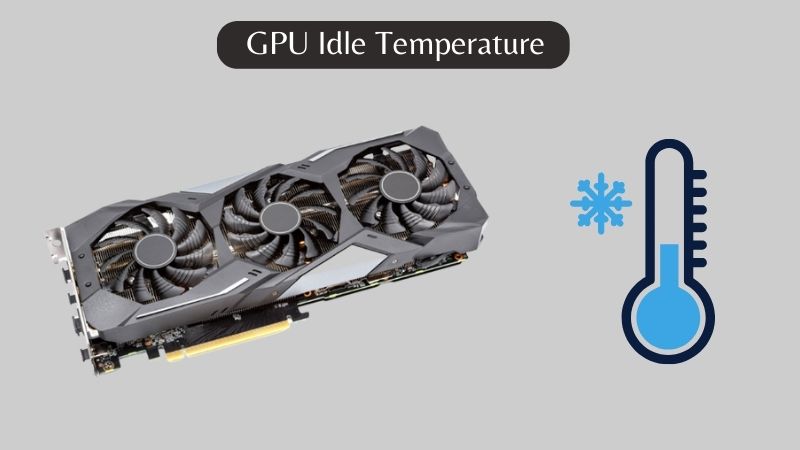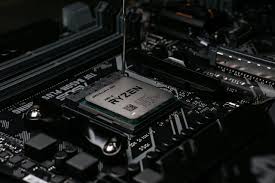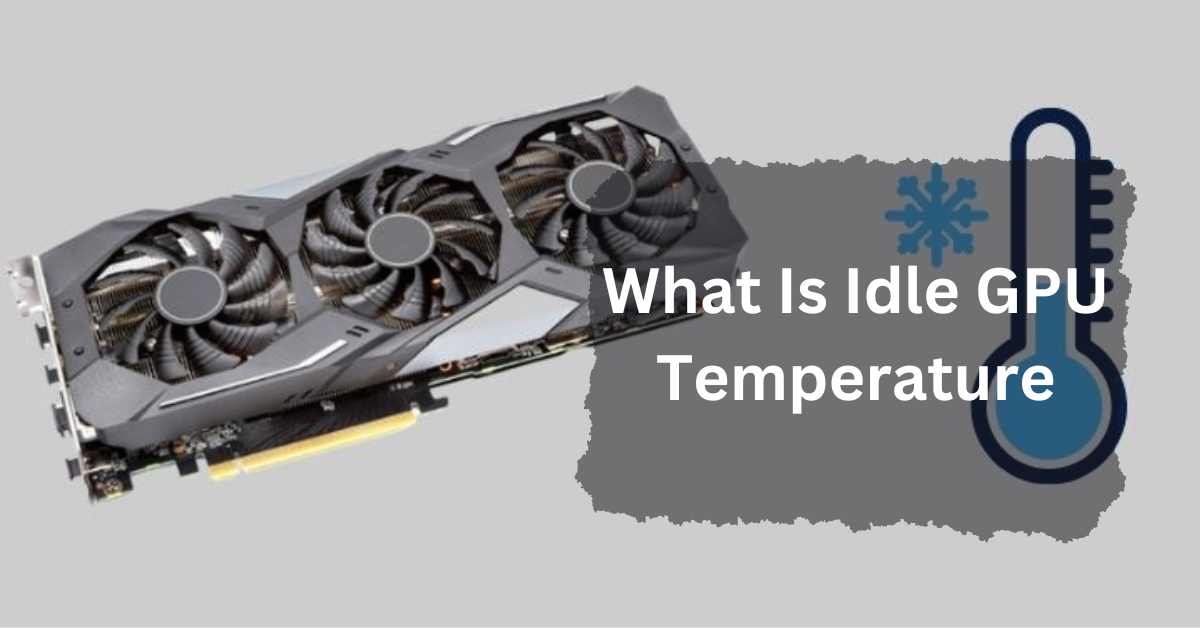Graphics Processing Units, or GPUs, are essential components in modern computers, especially for gaming and graphic-intensive tasks. Just like any other component, they generate heat while operating. Monitoring GPU temperature is crucial to ensure your system runs smoothly and to avoid potential damage.
Idle GPU temperature is the heat level of your graphics card when it’s not doing heavy tasks. Typically, it should be between 30°C and 50°C. If the temperature is higher, check for dust or improve airflow in your computer case.
In this article, we will discuss “What Is Idle GPU Temperature”.
Table of Contents
Understanding GPU Temperature:
GPUs are the powerhouse behind stunning graphics and smooth gameplay. However, this power comes with heat generation.
As your GPU processes data, it gets warm. To prevent overheating, GPUs come with built-in cooling systems, such as fans and heatsinks. These systems help maintain a safe operating temperature.
Why Idle GPU Temperature Matters?
Keeping an eye on your idle GPU temperature is important for several reasons. A high idle temperature can shorten the lifespan of your GPU and affect overall system performance. It’s a good indicator of the cooling efficiency and can help you catch potential issues early.
Factors Affecting Idle GPU Temperature:

1. Ambient Room Temperature:
The temperature of your room can influence your GPU’s idle temperature. Warmer rooms can cause higher idle temperatures.
2. Quality of the Cooling System:
A robust cooling system with efficient fans and heatsinks can keep your GPU cooler at idle.
3. GPU Model and Manufacturer:
Different GPU models have varying designs and cooling capabilities. High-end GPUs often have better cooling solutions.
4. System Airflow:
Proper airflow within your computer case helps dissipate heat more effectively, keeping your GPU temperature lower.
Read: Is Minecraft CPU Or GPU Intensive – Complete Guide – 2024!
Why Is Monitoring Idle GPU Temperature Important?
1. Early Detection of Cooling Issues:
By monitoring your GPU’s idle temperature, you can spot potential cooling problems early on.
2. Ensuring Optimal Performance:
A cooler GPU performs better. Overheating can throttle performance.
3. Extending GPU Lifespan:
Keeping your GPU cool can prolong its lifespan, saving you money in the long run.
How to Check Idle GPU Temperature?
1. Using Built-in Software:
Many GPUs come with software from the manufacturer to monitor temperatures.
2. Third-Party Monitoring Tools:
Tools like MSI Afterburner and HWMonitor provide detailed temperature readings.
3. BIOS/UEFI Settings:
You can also check temperatures in your system’s BIOS or UEFI settings.
Read: Is 70 GPU Temp Bad – A Ultimate Guide Of 2024!
Ideal Idle GPU Temperatures for Different GPUs:
1. NVIDIA GPUs:
NVIDIA GPUs typically idle between 30°C and 45°C (86°F to 113°F).
2. AMD GPUs:
AMD GPUs often idle between 40°C and 50°C (104°F to 122°F).
When to Worry About Idle GPU Temperature?
1. Identifying Warning Signs:
If your GPU’s idle temperature is consistently above 50°C (122°F), it might indicate a problem.
2. Recommended Actions:
Check for dust buildup, ensure proper ventilation, and consider upgrading your cooling system.
Impact of Idle GPU Temperature on Gaming and Performance:
1. Relationship Between Idle and Load Temperatures:
Higher idle temperatures can lead to higher load temperatures, affecting performance.
2. Performance Benchmarks:
Maintaining optimal idle temperatures can result in better performance benchmarks.
How to Maintain Optimal Idle GPU Temperature?
1. Routine Maintenance Practices:
Regularly clean your computer and check for dust buildup.
2. Software Updates and Settings Adjustments:
Keep your GPU drivers and software up to date for optimal performance.
What’s a Good Idle Temperature for a GPU?
A good idle temperature for a GPU is between 30-45°C (86-113°F). Keeping your GPU within this range helps ensure it runs smoothly and lasts longer.
Read: Do Both Monitors Need To Be Connected To The GPU – Complete Guide!
What Causes High GPU Temperatures?
1. Inadequate Cooling:
Poor ventilation or cooling can cause the GPU to overheat. Ensure your computer has enough fans and clean air pathways.
2. High Ambient Temperature:
A hot environment can increase GPU temperatures. Keep your computer in a cool, well-ventilated area.
3. Overclocking:
Pushing the GPU beyond its standard speed can lead to higher temperatures. Consider lowering the clock speed to reduce heat.
4. Dust Buildup:
Dust can clog fans and vents, restricting airflow and causing overheating. Regularly clean your computer to prevent dust buildup.
5. Running Intensive Applications:
Heavy tasks like gaming or video editing can push the GPU to its limits, raising temperatures. Take breaks or close unnecessary applications.
6. Faulty Hardware:
Defective cooling components or thermal paste can lead to poor heat dissipation. Check and replace faulty hardware if needed.
How to Lower Idle GPU Temperature?
If you notice your GPU temperature is higher than normal, here are a few steps you can take:
- Improving Airflow: Ensure that your case has good ventilation and fans are working properly.
- Cleaning the GPU: Regularly clean your GPU and the interior of your computer to remove dust.
- Adjusting Settings: Sometimes, tweaking the fan speed or lowering the clock speed can help.
Read: What Is GPU Hotspot – A Complete Guide Of 2024!
Cooling Solutions for GPUs?
There are various cooling solutions available to manage your GPU temperature:
- Air Cooling: Most common and involves fans to dissipate heat.
- Liquid Cooling: More efficient and quieter but also more expensive.
- Hybrid Cooling: Combines air and liquid cooling for optimal performance.
Read: Is 12GB GPU Enough For Gaming – A Ultimate Guide of 2024!
How to Check GPU Temperature?

To check GPU temperature, use software like MSI Afterburner or HWMonitor. These programs show the temperature in real-time, helping you monitor and manage your GPU’s health.
What to do if the GPU temperature is too high?
If your GPU temperature is too high, clean dust from fans, improve case ventilation, lower graphics settings, or stop overclocking. You can also use software to adjust fan speeds for better cooling.
GPU idle temp Fahrenheit?
A good idle temperature for a GPU in Fahrenheit is between 86-113°F. Keeping the GPU in this range helps ensure it works well and lasts longer.
GPU idle temp 50?
If your GPU idle temperature is 50°C (122°F), it’s a bit high. Check for dust, improve airflow, or adjust fan settings to help lower the temperature.
Is 30 degrees idle good GPU?
Yes, a GPU idle temperature of 30°C (86°F) is good. It shows that your GPU is staying cool and has good cooling and airflow.
Is 45 degrees idle good GPU?
Yes, a GPU idle temperature of 45°C (113°F) is good. It indicates that your GPU is running at a safe temperature and has adequate cooling and airflow.
is 45 degrees a good idle temp for a gpu?
Yes, 45 degrees Celsius (113°F) is a good idle temperature for a GPU. It means the GPU is staying cool and your cooling system is working well.
Is 50C good for GPU idle?
No, 50°C (122°F) is a bit high for a GPU idle temperature. It’s better to aim for temperatures between 30-45°C (86-113°F) for optimal performance.
Idle Gpu temp at 54c?
An idle GPU temperature of 54°C (129°F) is a bit high. It’s good to check cooling and airflow in your computer to help lower the temperature for better performance.
GPU idle temp 60?
A GPU idle temperature of 60°C is a bit high but may not be dangerous. Check your cooling system and ensure your computer has good airflow to prevent overheating during intensive tasks.
Why is my GPU hot (60 C at idle)?
Your GPU is hot at 60°C idle likely due to poor ventilation, dust buildup, or high ambient temperature. Check fans, clean the system, and ensure your computer is in a cool, open space.
Is 70 C too hot for a GPU?
No, 70°C is not too hot for a GPU. It’s a normal temperature under load. However, ensure good cooling and airflow to keep it from getting hotter and causing potential issues.
Read: Is It Okay For My GPU To Be At 100 – Complete Guide – 2024
What is a safe GPU temperature?
A safe GPU temperature is usually between 30°C to 70°C when idle or under normal use. During heavy tasks, temperatures up to 85°C are acceptable but try to keep it below this.
Read: Is 74c Bad For GPU – A Complete Guide Of 2024!
What is a normal GPU temperature?
A normal GPU temperature is around 30°C to 60°C when idle and can reach up to 85°C during heavy use. Ensure good cooling to maintain these temperatures and prevent overheating.
Normal idle GPU temp laptop?
A normal idle GPU temperature for a laptop is between 40°C and 60°C. Ensure good airflow and clean fans to keep the temperature within this range and avoid overheating.
Normal GPU temp while gaming?
A normal GPU temperature while gaming is between 60°C and 85°C. Ensure good cooling and airflow to keep your GPU within this range and prevent overheating or performance issues.
What is a good idle CPU temp?

A good idle CPU temperature is between 30°C and 50°C. Ensure your computer has good cooling and clean fans to maintain this temperature range and avoid overheating.
FAQs:
1. What is a dangerous idle GPU temperature?
A dangerous idle GPU temperature is generally above 60°C. Consistently high temperatures at idle can indicate cooling issues.
2. How often should I check my GPU temperature?
It’s a good practice to check your GPU temperature every few weeks, or more often if you’re experiencing performance issues.
3. Can high idle GPU temperature damage my system?
Yes, high idle temperatures can lead to long-term damage to your GPU and other components due to excessive heat.
4. What is the best cooling solution for GPUs?
The best cooling solution depends on your needs. Air cooling is sufficient for most users, but liquid cooling offers better performance for high-end systems.
5. Does overclocking affect idle GPU temperature?
Yes, overclocking can increase idle GPU temperature as the GPU operates at higher speeds even when not under load.
Conclusion:
Monitoring idle GPU temperature is essential for maintaining your system’s health. Keep your GPU idle temperature between 30°C and 50°C for optimal performance. Regular maintenance, proper ventilation, and checking for dust can help keep temperatures low and extend the life of your GPU.

I’m Noah Lucas, the voice behind the content you find here. With 5 years of experience in the GPU field, my goal is to provide clear and helpful information to everyone interested in this technology.
Whether you’re new to GPUs or looking to deepen your understanding, my articles aim to break down complex topics into simple, easy-to-understand language. This way, no matter where you’re from, you can find the information you need without any confusion.

